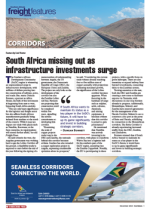The Southern African Development Community (SADC) region is witnessing an unprecedented surge in infrastructure development, with millions of dollars pouring into the construction of railways, ports, and roads. But, warns Duncan Bonnett, a partner at Africa House, the bulk of this investment is happening from east to west, bypassing South Africa entirely.“This not only bears significance for the logistics and freight sector but also affects South African manufacturers gradually being isolated from markets to the north of the country. While it may not impact our trade with places such as Namibia, Botswana, or the Sacu countries, its repercussions will extend farther afield,” he told Freight News.He said towards the west, the Angolan government was working hard to get the Lobito Corridor off the ground. A feasibility study is expected to start before the end of the year following the signing of a memorandum of understanding between Angola, the US government, the Democratic Republic of Congo (DRC), the European Union and Zambia. The project not only looks at the development of the corridor but also the Zambia-Lobito rail line. Partners are projecting that construction could be completed within five years, signalling the serious commitment to developing this corridor.“Examining the scale of copper projects under way in the DRC and Zambia, the rationale behind this corridor becomes evident. Ivanhoe has also revealed a copper exploration project in Angola, expressing considerable optimism about its prospects,” he said. “Considering the current trade volume already reaching four to five million tons of copper annually, with projections indicating sustained growth, the significance of the Lobito corridor becomes apparent. When factoring in the backhaul of cargo such as sulphur, acids, solvents, chemicals, and mining equipment, it becomes evident that this corridor is poised to gain prominence.”He mentioned that Namibia was actively investing in its corridors, with plans to transform Walvis Bay into a logistics hub for the southern part of the SADC region, extending into the Zambia Copperbelt. Notably, the EU is participating in these projects, with a specific focus on green hydrogen. There are also intentions to expand railway lines beyond Grootfontein, connecting them to the Zambian system.Turning attention to the east, both the DRC and Zambia are creating a new route to facilitate exports via Tanzania, with discussions on one-stop borders already in progress. Additionally, Mozambique, Malawi, and Zambia have entered agreements for the management of the Nacala Corridor. Malawi is set to construct a dry port at the ports of Beira and Nacala, solidifying its connection to the Mozambican corridors. The Beira Corridor is already experiencing increased traffic from the DRC, Zambia, and Zimbabwe.Bonnett stressed that if South Africa wanted to maintain its status as a key player in the SADC's future, it would have to up its game significantly and invest in building strategic corridors.

